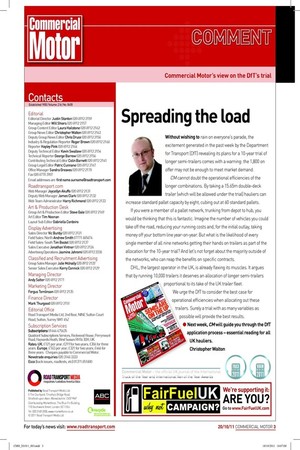Spreading the load
Page 2

If you've noticed an error in this article please click here to report it so we can fix it.
Without wishing to rain on everyone’s parade, the
excitement generated in the past week by the Department for Transport (DfT) revealing its plans for a 10-year trial of longer semi-trailers comes with a warning: the 1,800 on offer may not be enough to meet market demand.
CM cannot doubt the operational efficiencies of the
longer combinations. By taking a 15.65m double-deck trailer (which will be allowed under the trial) hauliers can increase standard pallet capacity by eight, cubing out at 60 standard pallets.
If you were a member of a pallet network, trunking from depot to hub, you would be thinking that this is fantastic. Imagine the number of vehicles you could take off the road, reducing your running costs and, for the initial outlay, taking money off your bottom line year-on-year. But what is the likelihood of every single member of all nine networks getting their hands on trailers as part of the allocation for the 10-year trial? And let’s not forget about the majority outside of the networks, who can reap the benefits on specific contracts.
DHL, the largest operator in the UK, is already flexing its muscles. It argues that by running 10,000 trailers it deserves an allocation of longer semi-trailers proportional to its take of the UK trailer fleet.
We urge the DfT to consider the best case for operational efficiencies when allocating out these trailers. Surely a trial with as many variables as possible will provide the best results.
• Next week, CM will guide you through the DfT application process – essential reading for all UK hauliers.
Christopher Walton










































